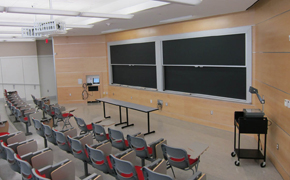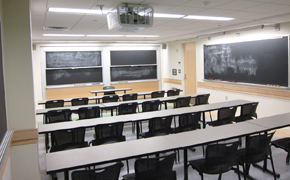Instructor Insights pages are part of the OCW Educator initiative, which seeks to enhance the value of OCW for educators.
Course Overview
This page focuses on the course 18.310 Principles of Discrete Applied Mathematics as it was taught by Professor Michel Goemans, Dr. Lorenzo Orechhia, Dr. Richard Peng, and Susan Ruff in Fall 2013.
This course introduced students to topics such as probability, counting, linear programming, number-theoretic algorithms, sorting, data compression, and error-correcting codes. It was also a Communication-Intensive in the Major ![]() course.
course.
Course Outcomes
Course Goals for Students
- Gain a basic understanding of topics in discrete mathematics
- Begin to communicate successfully as mathematicians
Possibilities for Further Study/Careers
This course prepared students to enroll in courses such as 18.212 Algebraic Combinatorics, 18.440 Probability and Random Variables, and 6.006 Introduction to Algorithms.
In the following pages, Michel Goemans, Peter Shor (a colleague in the Mathematics Department), Lorenzo Orecchia, and Susan Ruff describe various aspects of how 18.310 Principles of Discrete Applied Mathematics was developed and taught.
- Addressing Communication in Mathematics through Recitations
- Creating the Term Paper Assignment
- Assessing Students’ Writing
Curriculum Information
Prerequisites
18.02 Calculus II: Multivariable Calculus
GIR ![]()
Requirements Satisfied
- CI-M
 in Mathematics
in Mathematics
- 18.310 can be applied toward a Bachelor of Science in Mathematics.
Offered
Every fall
Assessment
The students' grades were based on the following activities:
 55% Problem sets and writing assignments
55% Problem sets and writing assignments 15% Quiz 1
15% Quiz 1 15% Quiz 2
15% Quiz 2 15% Quiz 3
15% Quiz 3The instructors discuss their assessment insights here.
Student Information

Breakdown by Year
About 50% sophomores and 50% juniors.
Breakdown by Major
Almost exclusively Mathematics majors or students with a double major in Mathematics and another concentration.
Typical Student Background
Many students entered the class with limited experience writing mathematical proofs.
Enrollment Cap
Enrollment in the recitations was limited to about 20 students in order to enable instructors to provide students with adequate writing support; this cap largely determined the overall enrollment cap of 70-80 students in the course.
During an average week, students were expected to spend 12 hours on the course, roughly divided as follows:
Lecture
- Met 3 times per week for 1 hour per session.
- Instructors demonstrated technical aspects of discrete applied mathematics; at the end of some lectures, they conducted computer demonstrations of key concepts.
Recitation
- Met 1 time per week for 1 hour per session; mandatory attendance.
- Instructors and students further discussed course content and how it related to professional writing and oral communication in the field of mathematics.
Out of Class
Students completed problem sets and writing assignments, including a term paper.
Semester Breakdown
| WEEK | M | T | W | Th | F |
|---|---|---|---|---|---|
| 1 |  |  |  |  |  |
| 2 |  |  |  |  |  |
| 3 |  |  |  |  |  |
| 4 |  |  |  |  |  |
| 5 |  |  |  |  |  |
| 6 |  |  |  |  |  |
| 7 |  |  |  |  |  |
| 8 |  |  |  |  |  |
| 9 |  |  |  |  |  |
| 10 |  |  |  |  |  |
| 11 |  |  |  |  |  |
| 12 |  |  |  |  |  |
| 13 |  |  |  |  |  |
| 14 |  |  |  |  |  |
| 15 |  |  |  |  |  |
| 16 |  |  |  |  |  |
 No classes throughout MIT
No classes throughout MIT Lecture session
Lecture session Homework/Writing Assignment Due
Homework/Writing Assignment Due No class session scheduled
No class session scheduled Recitation session
Recitation session Quiz
QuizLead Instructor (Prof. Michel Goemans)
- Delivered lectures
- Met with teaching team to plan recitations
- Co-facilitated norming meetings
- Assessed students’ writing
Recitation Leader (Dr. Lorenzo Orecchia)
- Met with team to plan recitations
- Taught recitations first, providing a model for other recitation leaders
- Participated in norming meetings
- Assessed students’ writing
Recitation Leader (Dr. Richard Peng)
- Met with team to plan recitations
- Led recitations
- Participated in norming meetings
- Assessed students’ writing
Writing Across the Curriculum Lecturer (Susan Ruff)
- Met with team to plan recitations
- Co-facilitated norming meetings
- Recorded recitations for research purposes
- Assessed students’ writing
- Coached undergraduate graders on assessing students’ writing
Undergraduate Graders
- Participated in norming meetings
- Assessed students’ writing


 Room 1 of 2
Room 1 of 2 
